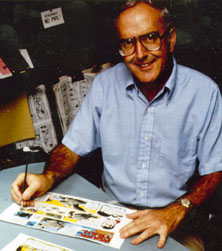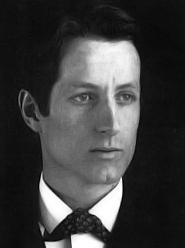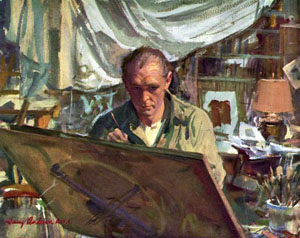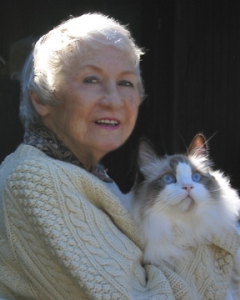
A cartoonist is a visual artist who specializes in both drawing and writing cartoons or comics. Cartoonists differ from comics writers or comics illustrators/artists in that they produce both the literary and graphic components of the work as part of their practice.

The Ben Day process is a printing and photoengraving technique for producing areas of gray or various colors by using fine patterns of ink on the paper. It was developed in 1879 by illustrator and printer Benjamin Henry Day Jr.. The process is commonly described in terms of Ben Day dots, but other shapes can be used, such as parallel lines or textures.

An illustrator is an artist who specializes in enhancing writing or elucidating concepts by providing a visual representation that corresponds to the content of the associated text or idea. The illustration may be intended to clarify complicated concepts or objects that are difficult to describe textually, which is the reason illustrations are often found in children's books.

Yoshitaka Amano is a Japanese visual artist, character designer, illustrator, a scenic designer for theatre and film, and a costume designer. He first came into prominence in the late 1960s working on the anime adaptation of Speed Racer. Amano later became the creator of iconic and influential characters such as Gatchaman, Tekkaman, Honeybee Hutch, and Casshern. In 1982 he went independent and became a freelance artist, finding success as an illustrator for numerous authors, and worked on best-selling novel series, such as The Guin Saga and Vampire Hunter D. He is also known for his commissioned illustrations for the popular video game franchise Final Fantasy.

Maxfield Parrish was an American painter and illustrator active in the first half of the 20th century. He is known for his distinctive saturated hues and idealized neo-classical imagery. His career spanned fifty years and was wildly successful: the National Museum of American Illustration deemed his painting Daybreak (1922) to be the most successful art print of the 20th century.

Mr. Clean is a brand name and mascot, owned by the American company Procter & Gamble, used for an all-purpose cleaner and later also for a melamine foam abrasive sponge.

Clip art is a type of graphic art. Pieces are pre-made images used to illustrate any medium. Today, clip art is used extensively and comes in many forms, both electronic and printed. However, most clip art today is created, distributed, and used in a digital form. Since its inception, clip art has evolved to include a wide variety of content, file formats, illustration styles, and licensing restrictions. It is generally composed exclusively of illustrations, and does not include stock photography.
James Jean is a Taiwanese-American visual artist working primarily in painting and drawing. He lives and works in Los Angeles, where he moved from New York in 2003.
Arthur Paul was an American graphic designer and the founding art director of Playboy magazine. During his time at Playboy, he commissioned illustrators and artists, including Andy Warhol, Salvador Dalí, and James Rosenquist, as part of the illustration liberation movement.

Mary GrandPré is an American illustrator best known for her cover and chapter illustrations of the Harry Potter books in their U.S. editions published by Scholastic. She received a Caldecott Honor in 2015 for illustrating Barb Rosenstock's The Noisy Paint Box: The Colors and Sounds of Kandinsky's Abstract Art. GrandPré, who creates her artwork with paint and pastels, has illustrated more than twenty books and has appeared in gallery exhibitions and periodicals such as The New Yorker, Atlantic Monthly, and The Wall Street Journal.
Norman Theodore Mingo was an American commercial artist and illustrator. He is most famous for being commissioned to formalize the image of Alfred E. Neuman for Mad.
Graphic design careers include creative director, art director, art production manager, brand identity developer, illustrator and layout artist.
Evaline Ness was an American commercial artist, illustrator, and author of children's books. She illustrated more than thirty books for young readers and wrote several of her own. She used a great variety of artistic media and methods.

Jessie Willcox Smith was an American illustrator during the Golden Age of American illustration. She was considered "one of the greatest pure illustrators". A contributor to books and magazines during the late 19th and early 20th centuries, Smith illustrated stories and articles for clients such as Century, Collier's, Leslie's Weekly, Harper's, McClure's, Scribners, and the Ladies' Home Journal. She had an ongoing relationship with Good Housekeeping, which included a long-running Mother Goose series of illustrations and also the creation of all of the Good Housekeeping covers from December 1917 to 1933. Among the more than 60 books that Smith illustrated were Louisa May Alcott's Little Women and An Old-Fashioned Girl, Henry Wadsworth Longfellow's Evangeline, and Robert Louis Stevenson's A Child's Garden of Verses.

Herbert F. Lubalin was an American graphic designer. He collaborated with Ralph Ginzburg on three of Ginzburg's magazines: Eros, Fact, and Avant Garde. He designed the typeface, ITC Avant Garde, for the last of these.

Vernon Simeon Plemion Grant was an American illustrator known for his whimsical gnome characters and fairy tale drawings. Over seven decades, Grant created hundreds of illustrations for advertising and major magazines, including Judge and Ladies' Home Journal. He is best known as creator of Kellogg's Rice Krispies cereal characters Snap! Crackle! and Pop!

Joseph Harry Anderson was an American illustrator and a member of the Illustrator's Hall of Fame. A devout Seventh-day Adventist artist, he is best known for Christian-themed illustrations he painted for the Adventist church and the Church of Jesus Christ of Latter-day Saints. He was also a popular illustrator of short stories in American weekly magazines during the 1930s and early 1940s.

Sheilah Beckett was an American illustrator, known for her work on the Little Golden Books series. She illustrated more than 70 classic fairy-tale titles for Little Golden Books, among them The Twelve Days of Christmas, The Twelve Dancing Princesses, and Snow White and Rose Red. She also illustrated several contemporary volumes of poetry, and a variety of 18th and 19th century adult works, including Lowell Baird's 1959 translation of Candide and a 1940 adaptation of Gilbert and Sullivan's HMS Pinafore. At the time of her death, Beckett resided and worked in Ossining, New York. Her final works done at the age of 99 were on the computer. Becket lived to be 100 years old.

Drew Struzan is an American artist, illustrator and cover designer. He is known for his more than 150 movie posters, which include The Shawshank Redemption, Blade Runner, Mallrats, as well as films in the Indiana Jones, Back to the Future, and Star Wars film series. He has also painted album covers, collectibles, and book covers.
Naiad June Einsel was an American commercial illustrator and artist. Over the course of her career, Einsel completed artwork for magazines, newspapers, and brands. Einsel, along with husband Walter, was inducted into the Society of Illustrators' Hall of Fame in 2008.
















